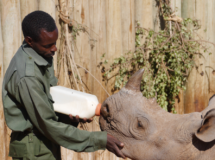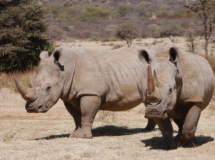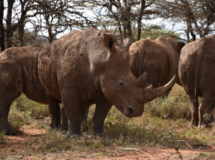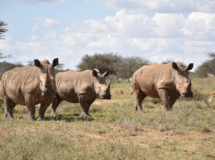

Kenya: Ol Jogi Conservancy
At 234 km2, and contiguous with other conservancies of the wider Laikipia landscape, Ol Jogi Wildlife Conservancy is home to a range of threatened species, including cheetahs, African wild dogs and the largest population of Grévy’s zebras in Africa as well as, of course, both black and white rhinos.
It was established more than 60 years ago and, in 1980, became the second privately owned rhino sanctuary in Kenya. A stronghold for the Eastern black rhino subspecies, the Conservancy has proven itself as one of the most successful rhino breeding programmes in the country. The rhino sanctuary was expanded in 2005 to incorporate the entire Conservancy, which is now home to a Key 2 population of Eastern black and a significant population of Southern white rhinos. As the populations have grown, Ol Jogi has contributed many rhinos to the national population by helping to restock areas where rhino numbers have dwindled or disappeared entirely.
Much of this success can be attributed to its inclusive philosophy of close collaboration and support for the neighbouring local communities with which it shares the landscape.
The problem
In the 1970s and 80s, Kenya’s rhinos suffered heavy losses to poaching, reducing their numbers drastically from more than 20,000 to 350 during a mere 15-year period. Between its establishment in 1980 and 2012, the Conservancy saw great success in anti-poaching when not a single rhino was lost to poachers. But, when the poaching crisis that began in 2008 escalated, the threat intensified, and Ol Jogi suffered several attacks. Fortunately, no rhinos have been killed by poachers on the Conservancy since 2015, but the threat continues to shadow the rhinos and the team at Ol Jogi.
Beyond poaching, a major cause of mortality on the Conservancy currently comes from the rhinos themselves. As Kenya’s human population and economy has grown, there is very little space left for Kenya’s rhino populations to recover. Despite this, the long-term aim of Kenya’s wildlife authorities is to increase the country’s national black rhino population to 2,000 animals. To reach this aim, they are working with conservancies like Ol Jogi to create and grow large-scale new habitats with round-the-clock protection. However, whilst other animals are free to move across the Conservancy’s boundaries, rhinos are restricted for their own protection. On Ol Jogi, like other rhino conservancies in Kenya, there is the seeming paradox of there being too many rhinos for the amount of habitat available. Skirmishes between rhinos – particularly males – regarding the amount of space available has led to injuries and even deaths.
Furthermore, health issues – likely the result of a much-reduced population size – have become apparent. Laikipia’s black rhino population appears to have a high prevalence of inoperable cataracts in young black rhinos that often renders them blind. It is unclear at this stage whether this is a normal characteristic of the population and has only become noticeable in recent years due to intensive monitoring and protection, or whether it is a genetic defect that has become more common following the ‘genetic bottleneck’ of the 1980s.
Finally, as the climate continues to change, Ol Jogi has had to contend with increasingly unpredictable rainfall patterns. Subsequent droughts have reduced the amount of fodder available for rhinos and other herbivorous species.
How is Ol Jogi Conservancy tackling this problem?
More than 100 rangers are employed by Ol Jogi, each within one of three sections: National Police Reservists (NPRs), who form the armed anti-poaching unit; general security team members, who are deployed to man the gates and monitor the fence-lines; and the rhino monitors, who keep tabs on Ol Jogi’s rhino population. Rangers at Ol Jogi Conservancy receive annual training courses, which include tactical training, commander training, first aid and other field-craft techniques.
With large bribes offered by poaching syndicates, there is often temptation among staff working in rhino areas to provide information about a rhino’s whereabouts. In fact, nearly all recent poaching incidents can be attributed to poachers obtaining insider information. Therefore, it is imperative that rangers are motivated, content and safe both for their own welfare, their families’ welfare and the well-being of the very wildlife they are employed to protect. Ol Jogi has subsequently placed a great emphasis on providing quality equipment, rations, training courses and other resources such as celebratory “Rhino Dinners”, which recognise the achievements of the rangers, highlighting just how much their hard work is appreciated.
Ol Jogi also has a distinguished tracker dog team, being the first Kenyan conservancy to deploy anti-poaching dog units back in 1989, when it imported a team of Belgian Malinois. Lessons learned from this early adoption have now been put to great use in supporting the development of canine units in neighbouring rhino sanctuaries and other projects across Africa.
The Conservancy also works closely with its neighbouring communities and authorities to identify and investigate wildlife criminals and suspected poachers and traffickers. These communities benefit from the security provided by the Conservancy’s staff in the wider landscape, helping to prevent theft and other petty crimes in the surrounding areas.
Ol Jogi has its own primary school of 230 students that runs sustainable water projects in the community and teaches the community about sustainable grazing practices for cattle within a confined area. The Conservancy supports a medical clinic, a Maasai women’s group, and has various micro-finance programmes to encourage business development in Laikipia County. It also works to reduce human-wildlife conflict, including by maintaining a fence that surrounds the Conservancy but incorporates 18 rhino-proof corridors, facilitating the migration of other wildlife species along designated routes. Ol Jogi has also employed a Community Liaison Manager and is in the process of developing a new Community Partnership Strategy. Collectively, these efforts work towards creating a stable environment for rhino populations and communities to thrive.
Intense management of the Conservancy’s rhino population itself, however, is key for its continued health and reproductive output. Ol Jogi carries out ear-notching operations so that sub-adults can be identified easily once they leave their mothers. The ability to ID individual animals is crucial not only for monitoring rhino population performance, but also to identify any ‘missing’ animals that might have been poached.
Jamie Gaymer, Conservation Manager at Ol Jogi, and Chair of the Association of Private and community Land Rhino Sanctuaries (APLRS) is coordinating the development of a Laikipia-wide range expansion programme for black rhinos. Such efforts to establish new populations in Kenya will not only expand the amount of habitat available but will relieve the pressure on Ol Jogi’s and other rhino-bearing conservancies’ existing populations, reducing mortalities from territorial disputes, and improving breeding performance.
Research is also being carried out to ascertain the cause of the cataracts found in a number of black rhinos. The project will identify the ‘normal ocular parameters’ (normal eye function) of the black rhino eye, whilst detecting and classifying ocular pathology in the wild population. Once research authorisation is granted by the relevant authorities, Ol Jogi hopes to carry out whole-genome sequencing on DNA samples to identify the gene responsible for the issue. By establishing whether these cataracts are heritable and detecting associated genetic variants, findings will help to inform management practices for Eastern black rhinos in Kenya.

Bottle feeding orphaned or injured young rhinos is crucial for their survival.

The ranger team protects and monitors rhinos, and supports maintenance of the fence line.

Recently, drought has impacted the amount of food available to rhinos at Ol Jogi.

Black rhino calves like this one are looked after by rangers if they are orphaned, or injured.

This fence allows other species to go through into the next area, but keeps rhinos within the boundary.

Ol Jogi's canine unit was one of the first established in Africa.

The Conservancy has more than 100 rangers keeping rhinos and other endangered species safe.

Ol Jogi is 234 square kilometers in total, home to Eastern black rhinos and Southern white rhinos.

The Conservancy has a veterinary clinic on site to support its dogs and wildlife.

Rangers at Ol Jogi look after injured black rhinos, like this one, Alfie, who is blind.

Alongside rhinos, the Conservancy has a significant population of the rare Grevy's zebra.

Ol Jogi is home to Southern white rhinos.

View of Mount Kenya from Ol Jogi.
Our work
We have supported rhino conservation efforts at Ol Jogi Wildlife Conservancy for many years. Most recently, thanks to generous donors, between April 2022 and March 2023 we sent grants amounting to more than £240,000. Our funds have helped with: fixed-wing aerial surveillance, ranger training courses and uniforms, canine units, rations, intelligence gathering, a new Toyota Land Cruiser and helicopter flights for rhino ear-notching operations.
We have also covered the costs of veterinary interventions to save the lives of injured rhinos, including those caught up in territorial disputes with other rhinos, and have managed a grant for the research project investigating the cause of bi-lateral cataracts in Kenya’s black rhino population, including equipment, DNA analyses, the travel costs of the geneticists and research licences.
Rhino Dog Squad Appeal 2015
 Protecting Rhinos
Protecting Rhinos
 Reducing Illegal Horn Trade
Reducing Illegal Horn Trade
 Involving Communities
Involving Communities
 Bringing Experts Together
Bringing Experts Together


















